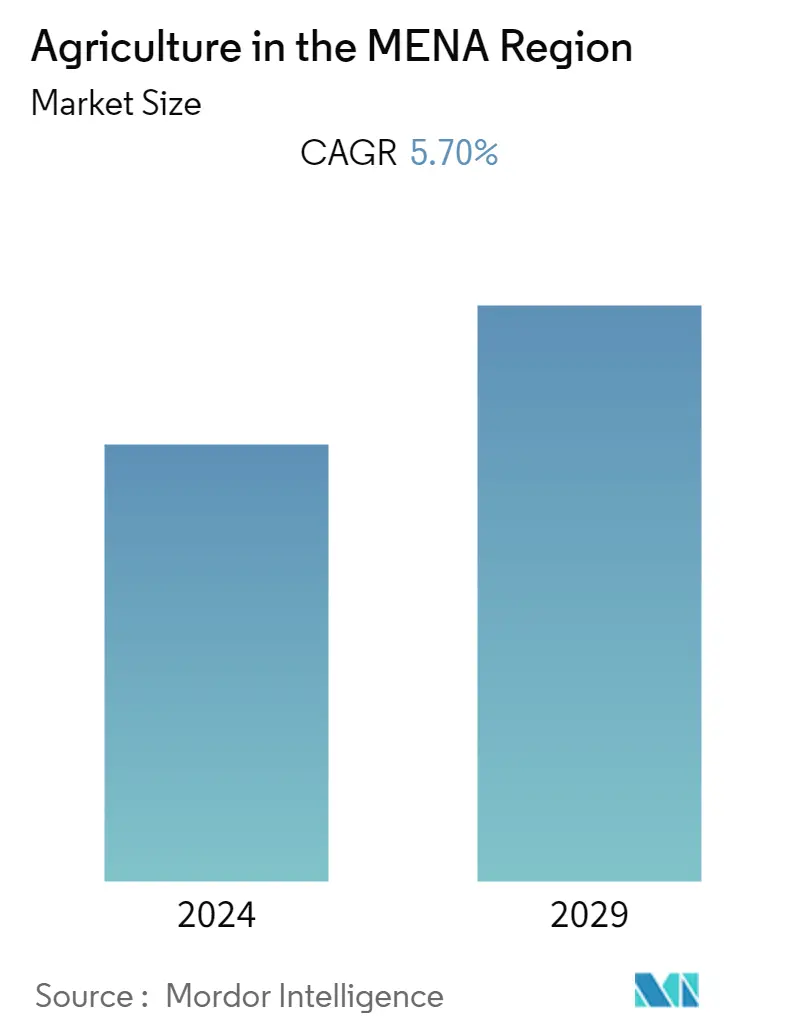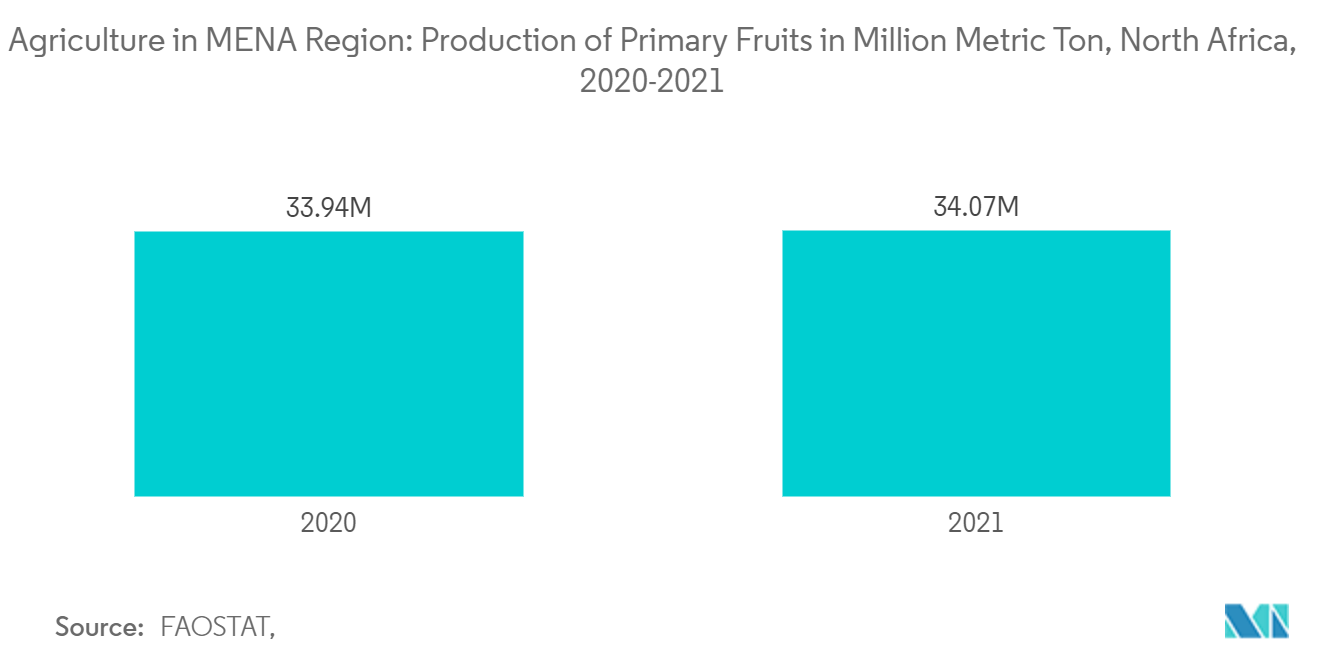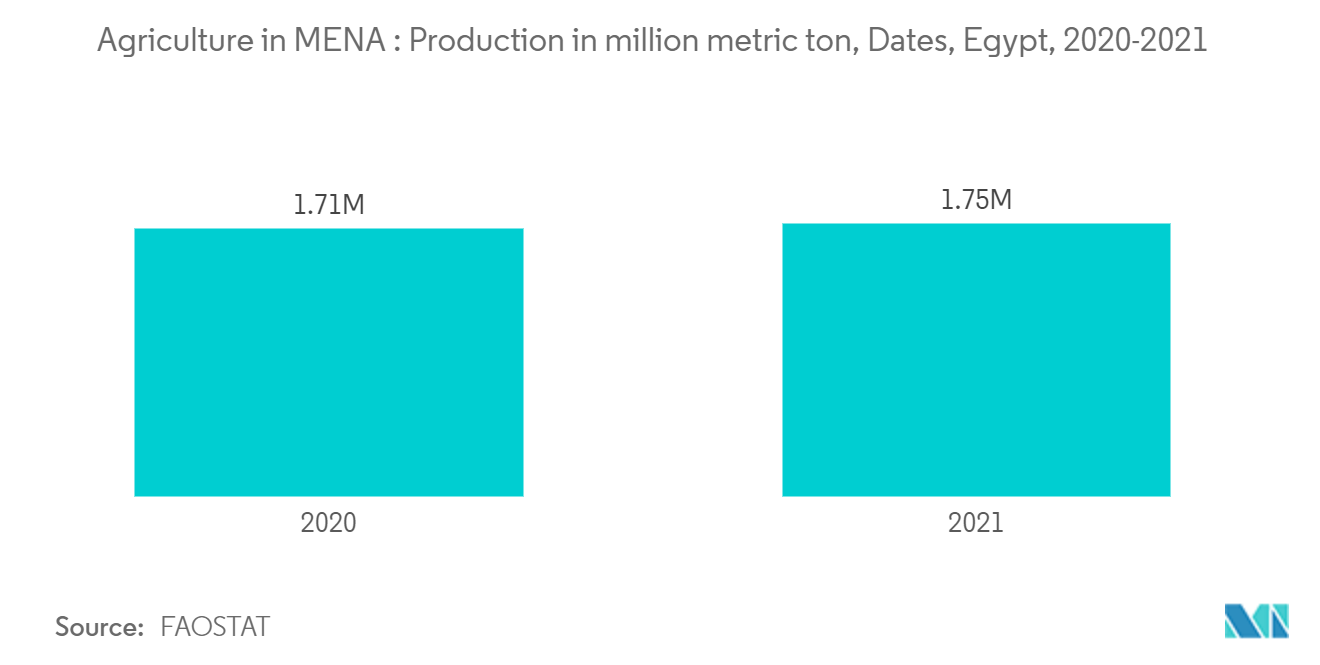MENA Agriculture Market Size

| Study Period | 2019 - 2029 |
| Base Year For Estimation | 2023 |
| Forecast Data Period | 2024 - 2029 |
| Historical Data Period | 2019 - 2022 |
| CAGR | 5.70 % |
Major Players*Disclaimer: Major Players sorted in no particular order |
MENA Agriculture Market Analysis
The agriculture market in the MENA (Middle East and North Africa) region is projected to record a CAGR of 5.7% during the forecast period.
- The Middle East and North Africa region comprise 14 low and middle-income countries or territories stretching from Iran to Morocco. In 2022, the region had a population of 486.1 million people, and about 165.3 million lived in rural areas. Of these, about 89 million depend on agriculture, including fishing and livestock. The region covers an area of 1,200 million hectares and includes diverse environments.
- Rainfed crops are grown during the wetter winter period, while irrigated areas are cultivated year-round. The main rainfed crops are wheat, barley, legumes, olives, grapes, fruit, and vegetables. A wide range of subtropical crops, including fruit and vegetables, is also grown under irrigation in summer.
- Livestock, mainly sheep and goats, are an important feature of many farming systems and provide key linkages between and within the different systems. Water-efficient irrigation is expanding and enabling intensive production of high-value cash and export crops, including fruits and vegetables.
- A dominant concern in the MENA region is its high and growing dependence on the international markets for key staple food products as arable land and water grow scarcer. The governments of various countries have taken steps to conserve water by banning the production of water-thirsty crops, such as wheat and green fodder. Food demand is increasing in the MENA region, mainly for two key reasons: population growth and rising incomes.
- According to the Food and Agricultural Organization (FAO), the land reform issue remains one of the most intractable, as many people hold onto their fragmented holdings without any rationalization or consolidation processes in place, even where countries are officially undertaking land reforms. The only places where there have been major changes are where larger operators can buy out smaller farmers. It is widely recognized that reorganizing land holdings is a prerequisite for introducing technologies to conserve soil and water resources in the long run. Thus, the proper use of agricultural resources, new technology, and favorable policies are expected to be crucial in driving the region's agriculture sector during the forecast period.
- The increased consumption of healthy and nutritional diets enhanced the consumption of cereals and fruits in the region. However, the lower GDP of African region countries, and farm labor shortages, especially for high-value crops, are major constraints to the growth of agriculture in the region.
MENA Agriculture Market Trends
This section covers the major market trends shaping the MENA Agriculture Market according to our research experts:
Quest for Food Self-sufficiency is Driving Production
- Among the food security challenges in the region, undernourishment, poverty, low agricultural productivity under scarce natural resources, and food import dependency pose the main problems. To tackle the increasing dependency on imports, countries in the region are taking several measures to ramp up production, as there are opportunities to partially address food insecurity by increasing production.
- For instance, in 2021, a political blockade in Qatar turned into a boon for its food security as the Ministry of Economy and Commerce (MEC), in cooperation with shopping malls and large retail outlets, unveiled the "National Product" of the "Made in Qatar" initiative. Under this initiative, farmers are growing fruits and vegetables in greenhouses, which are being sold as goods bearing the slogan "National Product" prominently to facilitate consumers' access to these products.
- According to a Food and Agriculture Organization (FAO) report titled "The State of Food Insecurity in the World," Morocco has significantly reduced hunger by maximizing production from large-scale farms and supporting small-scale farms in reducing poverty and hunger through venture capitalism. According to Food and Agriculture Organization Corporate Statistical Database (FAOSTAT), the production of grains in Morroco grew from 10.4 million tons in 2018 to 10.5 million tons in 2021. Similarly, in North Africa, the production of fruits and vegetables showed a significant rise in 2021 compared to 2019, with a production of 35.2 million metric tons of vegetables and 34.1 million metric tons of fruits in 2021. Thus, the quest for achieving food self-sufficiency is majorly driving agricultural production in the MENA region.

Egypt Dominates the Region
- Egypt is the region's highest producer of fruits and vegetables, closely followed by Iran. Fruits and vegetables are the most suitable crops for the climatic conditions of countries in the MENA region. The countries in the region direct their scarce water resources to more value-added crops, such as fruit and vegetables grown in greenhouses, as opposed to growing water-intensive cereal crops.
- According to Food and Agriculture Organization (FAO), Egypt produced 14.1 million tons of primary fruits and 15.6 million tons of primary vegetables in 2021. Egypt is also a significant exporter of fruit and vegetables to the European Union. Major fruits and vegetables produced in the region are grapes, dates, watermelon, bananas, oranges, sugarcane, eggplants, and potatoes.
- According to Food and Agriculture Organization (FAO), the production of dates increased by 12% between 2018 and 2021 to reach a volume of 1.75 million metric tons in 2021. In 2022, The Egyptian government has invested about USD 2.73 billion to increase the production output and has initiatives for integrated agriculture development programs such as the South Valley Development Project (Toshka), the Egyptian Rural Development Project, and the North and Central Sinai Development Project. Hence, the production of fruits and vegetables is likely to increase, which is expected to drive the whole agricultural sector in the country during the forecast period.

MENA Agriculture Market News
- September 2022: A new vertical farming facility was opened in Dubai, UAE, developed by a joint venture between Emirates Flight Catering and Crop one with an investment of USD 40 million for the facility.
- July 2022: Egypt's Ministry of Planning is investing USD 2.73 billion in 2022-2023 to expand production in the agriculture sector, adopt new technologies such as vertical farming, and focus on drafting new policies.
MENA Agriculture Market Report - Table of Contents
1. INTRODUCTION
- 1.1 Study Assumptions and Market Definitions
- 1.2 Scope of the Study
2. RESEARCH METHODOLOGY
3. EXECUTIVE SUMMARY
4. MARKET DYNAMICS
- 4.1 Market Overview
- 4.2 Market Drivers
- 4.3 Market Restraints
5. MARKET SEGMENTATION
-
5.1 Food Crops/Cereals
- 5.1.1 Production Analysis
- 5.1.2 Consumption Analysis (Value & Volume)
- 5.1.3 Import Analysis (Value & Volume)
- 5.1.4 Export Analysis (Value & Volume)
- 5.1.5 Price Trend Analysis
-
5.2 Fruits
- 5.2.1 Production Analysis
- 5.2.2 Consumption Analysis (Value & Volume)
- 5.2.3 Import Analysis (Value & Volume)
- 5.2.4 Export Analysis (Value & Volume)
- 5.2.5 Price Trend Analysis
-
5.3 Vegetables
- 5.3.1 Production Analysis
- 5.3.2 Consumption Analysis (Value & Volume)
- 5.3.3 Import Analysis (Value & Volume)
- 5.3.4 Export Analysis (Value & Volume)
- 5.3.5 Price Trend Analysis
-
5.4 Oilseeds/Non-food Crops
- 5.4.1 Production Analysis
- 5.4.2 Consumption Analysis (Value & Volume)
- 5.4.3 Import Analysis (Value & Volume)
- 5.4.4 Export Analysis (Value & Volume)
- 5.4.5 Price Trend Analysis
6. REGIONAL ANALYSIS
- 6.1 PESTLE Analysis
- 6.2 Supply Chain Analysis
- 6.3 Government Policies
7. COMPETITIVE LANDSCAPE
- 7.1 Distribution Network and Retail Analysis
- 7.2 Profile of Key Players
8. MARKET OPPORTUNITIES AND FUTURE TRENDS
** Subject To AvailablityMENA Agriculture Industry Segmentation
Agriculture is the science or practice of farming, including the cultivation of the soil to grow crops and the rearing of animals to provide food, wool, and other products.
The report includes production analysis (volume), consumption analysis (value and volume), export analysis (value and volume), import analysis (value and volume), and price trend analysis for each of the abovementioned segments.
The report offers market estimation and forecasts in value (USD million) and volume (metric ton) for the abovementioned segments.
| Food Crops/Cereals | Production Analysis |
| Consumption Analysis (Value & Volume) | |
| Import Analysis (Value & Volume) | |
| Export Analysis (Value & Volume) | |
| Price Trend Analysis | |
| Fruits | Production Analysis |
| Consumption Analysis (Value & Volume) | |
| Import Analysis (Value & Volume) | |
| Export Analysis (Value & Volume) | |
| Price Trend Analysis | |
| Vegetables | Production Analysis |
| Consumption Analysis (Value & Volume) | |
| Import Analysis (Value & Volume) | |
| Export Analysis (Value & Volume) | |
| Price Trend Analysis | |
| Oilseeds/Non-food Crops | Production Analysis |
| Consumption Analysis (Value & Volume) | |
| Import Analysis (Value & Volume) | |
| Export Analysis (Value & Volume) | |
| Price Trend Analysis |
MENA Agriculture Market Research FAQs
What is the current MENA Region Agriculture Market size?
The MENA Region Agriculture Market is projected to register a CAGR of 5.70% during the forecast period (2024-2029)
What years does this MENA Region Agriculture Market cover?
The report covers the MENA Region Agriculture Market historical market size for years: 2019, 2020, 2021, 2022 and 2023. The report also forecasts the MENA Region Agriculture Market size for years: 2024, 2025, 2026, 2027, 2028 and 2029.
MENA Agriculture Industry Report
Statistics for the 2024 MENA Agriculture market share, size and revenue growth rate, created by Mordor Intelligence™ Industry Reports. MENA Agriculture analysis includes a market forecast outlook to 2029 and historical overview. Get a sample of this industry analysis as a free report PDF download.



